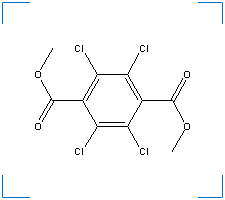Data Collection
DCPA
CAS Number: 1861-32-1
Basic Information
 Synonym(s): 2,3,5,6-tetrachloro-1,4-Benzenedicarboxylic acid dimethyl ester; dimethyl 2,3,5,6-tetrachloro-1,4-benzenedicarboxylate; Dimethyl 2,3,5,6-Tetrachloroterephthalate; Dimethyl tetrachloroterephthalate; Chlorthal-dimethyl; Chlorthal-methyl; DAC 893; Dachtal; D
Synonym(s): 2,3,5,6-tetrachloro-1,4-Benzenedicarboxylic acid dimethyl ester; dimethyl 2,3,5,6-tetrachloro-1,4-benzenedicarboxylate; Dimethyl 2,3,5,6-Tetrachloroterephthalate; Dimethyl tetrachloroterephthalate; Chlorthal-dimethyl; Chlorthal-methyl; DAC 893; Dachtal; D
Formula: C10H6Cl4O4
Molecular Weight: 331.967
Melting Point (°C): 155 - 156
Contaminant Type: DCPA is an herbicide.
Solubility (in water)
- Solubility:
0.05
g/100ml
d
- Solubility:
5
mg/l
h
Temperature (°C): 25
- Solubility:
5
mg/l
ak
Temperature (°C): 25
Half-Life (in soil unless otherwise noted)
- t1/2:
14-100
days
h
Environment: moisture is essential for degradation
- t1/2:
45
days
ak
Environment: in sandy soil
Formulation: calculated
- t1/2:
~100
days
al
Environment: most soils
- t1/2:
18-92
days
f
Environment: scientific judgement based upon unacclimated soil grab sample data
Toxicity Effects
- Organism Type:
Fish
ak
Common Name: Bluegill
Scientific Name: Lepomis macrochirus
Toxicity: 700 mg/l
Test: 48h LC50
- Organism Type:
Mammals
h
Common Name: Dog
Scientific Name: Canis (Genus)
Toxicity: >10000 mg/kg
Test: LD50
Notes: beagle
- Organism Type:
Mammals
g
Common Name: Rat
Scientific Name: Muridae (Family)
Toxicity: >10000 mg/kg
Test: LD50
- Organism Type:
Mammals
ak
Common Name: Rat
Scientific Name: Muridae (Family)
Toxicity: >3000 mg/kg bw
Test: LD50
- Organism Type:
Mammals
h
Common Name: Rat
Scientific Name: Muridae (Family)
Toxicity: 3000-12500 mg/kg
Test: LD50
- Organism Type:
Mammals
h
Common Name: Rat
Scientific Name: Muridae (Family)
Toxicity: 5500 mg/kg
Test: LD50
- Organism Type:
Mammals
ah
Common Name: Rat
Scientific Name: Muridae (Family)
Toxicity: >10000 mg/kg
Test: LD50
Soil Organic Carbon/Water Partition Coefficients
- Koc:
3.81
k
Formulation: log - calculated
Octanol-Water Partition Coefficients
- Log Kow:
4.87
k
Formulation: calculated
Work Cited
|
d
|
ChemFinder. Cambridge MA: CambridgeSoft Corporation. Retrieved November, 2003 from http://chemfinder.cambridgesoft.com
|
|
f
|
Howard, P. H., R. S. Boethling, W. F. Jarvis, W. M. Meylan, and E. M. Michalenko. 1991. Handbook of Environmental Degradation Rates. Lewis Publishers., Chelsea, MI.
|
|
g
|
Meister, R. T., and C. Sine (Ed). 2003. Crop Protection Handbook, volume 89. Meister Publishing Company, Willoughby, OH.
|
|
h
|
Extension Toxicology Network. Pages retrieved November, 2003 from http://ace.orst.edu/info/extoxnet/. Oregon State University, Corvallis, OR.
|
|
k
|
Montgomery, J. H. 1993. Agrochemicals Desk Reference: Environmental Data. Lewis Publishers, Boca Raton, FL.
|
|
ah
|
Meisterpro.com. Pages retrieved March, 2004 from www.meisterpro.com. MeisterPRO Information Services - a division of Meister Media Worldwide, Willoughby, OH.
|
|
ak
|
Verschueren, K. 2001. Handbook of Environmental Data on Organic Chemicals, 4th edition. John Wiley & Sons, Inc., New York.
|
|
al
|
Speclab.com. 2003. Spectrum chemcial fact sheet. Pages retrieved April 2005 from http://www.speclab.com/compound/. Spectrum Laboratory Inc, Ft. Lauderdale, FL and Savannah, GA.
|